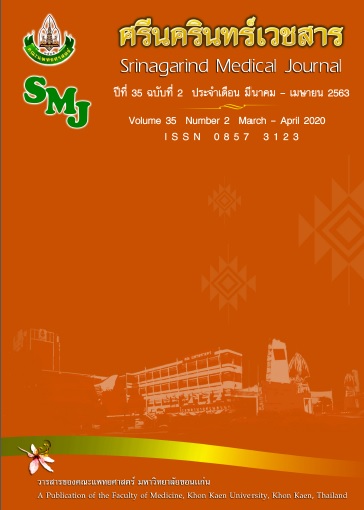การตรวจวัดปริมาณรังสีที่เลนส์ตาและต่อมไทรอยด์จากการตรวจซีทีสมองและปริมาณรังสีรอบภายในห้องซีที: การศึกษาในหุ่นจำลอง
คำสำคัญ:
เครื่องซีที; โอเอสแอล; ปริมาณรังสี; พื้นที่ควบคุม; พื้นที่ตรวจตรา, CT scan; OSL dosimeter; radiation dose; controlled area; supervised areaบทคัดย่อ
หลักการและวัตถุประสงค์: เพื่อวัดปริมาณรังสีที่เลนส์ตาและต่อมไทรอยด์จากการตรวจซีทีสมองด้วยเครื่องซีที 3 เครื่อง ร่วมกับการใช้และไม่ใช้บิสมัทป้องกันรังสี และการตรวจวัดปริมาณรังสีกระเจิงรอบห้องซีที
วิธีการศึกษา: ติดอุปกรณ์วัดปริมาณรังสีชนิดโอเอสแอลบนเปลือกตาและที่ผิวบริเวณต่อมไทรอยด์ของหุ่นจำลอง และติดที่ผนังคอนกรีต ประตูและกระจกตะกั่วระหว่างห้องซีทีบริเวณพื้นที่ควบคุมและพื้นที่ตรวจตรา
ผลการศึกษา: ปริมาณรังสีสมมูลของเครื่องซีที 3 เครื่อง จากการตรวจซีทีสมองด้วยโปรโตคอลต่าง ๆ มีค่าแตกต่างกันอย่างมีนัยสำคัญ พบว่า การใช้บิสมัทป้องกันรังสีช่วยลดปริมาณรังสีที่เลนส์ตาลงร้อยละ 27 – 48 การสำรวจปริมาณรังสีรอบห้องซีที พบว่า พื้นที่ตรวจตรามีค่าปริมาณรังสีอยู่ในเกณฑ์ที่กฎหมายกำหนด แต่บริเวณพื้นที่ควบคุม 2 ตำแหน่ง มีปริมาณรังสีเกินกว่าที่กำหนด จำเป็นต้องตรวจสอบและปรับปรุงต่อไป
สรุป: การปรับพารามิเตอร์ให้เหมาะสมโดยผู้ใช้จะช่วยลดปริมาณรังสีให้กับผู้ป่วยได้โดยเฉพาะในผู้ป่วยเด็ก การใช้บิสมัทช่วยลดการได้รับรังสีได้ การตรวจสอบประสิทธิภาพการป้องกันในพื้นที่ควบคุมและพื้นที่ตรวจตรามีความจำเป็น
เอกสารอ้างอิง
2. U.S. Food and Drug Administration. What are the Radiation Risks from CT? [updated 12/05/2017; cited Feburary 25, 2019]. Available from: https://www.fda.gov/Radiation-EmittingProducts/RadiationEmittingProductsandProcedures/MedicalImaging/MedicalX-Rays/ucm115329.htm.
3. Perisinakis K, Raissaki M, Theocharopoulos N, Damilakis J, Gourtsoyiannis N. Reduction of eye lens radiation dose by orbital bismuth shielding in pediatric patients undergoing CT of the head: a Monte Carlo study. Med Phys 2005; 32: 1024-30.
4. Raissaki M, Perisinakis K, Damilakis J, Gourtsoyiannis N. Eye-lens bismuth shielding in paediatric head CT: artefact evaluation and reduction. Pediatr Radiol 2010; 40: 1748-54.
5. Lim CS, Lee SB, Jin GH. Performance of optically stimulated luminescence Al(2)O(3) dosimeter for low doses of diagnostic energy X-rays. Appl Radiat Isot 2011; 69: 1486-9.
6. Okazaki T, Hayashi H, Takegami K, Okino H, Kimoto N, Maehata I, et al. Fundamental Study of nanoDot OSL Dosimeters for Entrance Skin Dose Measurement in Diagnostic X-ray Examinations. J Radiat Prot Res 2016; 41: 229-36.
7. Zhang D, Li X, Gao Y, Xu XG, Liu B. A method to acquire CT organ dose map using OSL dosimeters and ATOM anthropomorphic phantoms. Med Phys 2013; 40: 081918.
8. Suzuki S, Furui S, Ishitake T, Abe T, Machida H, Takei R, et al. Lens exposure during brain scans using multidetector row CT scanners: methods for estimation of lens dose. AJNR Am J Neuroradiol 2010; 31: 822-6.
9. Nikupaavo U, Kaasalainen T, Reijonen V, Ahonen SM, Kortesniemi M. Lens dose in routine head CT: comparison of different optimization methods with anthropomorphic phantoms. AJR Am J Roentgenol 2015; 204: 117-23.
10. Chodick G, Bekiroglu N, Hauptmann M, Alexander BH, Freedman DM, Doody MM, et al. Risk of cataract after exposure to low doses of ionizing radiation: a 20-year prospective cohort study among US radiologic technologists. Am J Epidemiol 2008; 168: 620-31.
11. Bordy JM. Monitoring of eye lens doses in radiation protection. Radioprotection 2015; 50: 177-85.
12. Wang J, Duan X, Christner JA, Leng S, Grant KL, McCollough CH. Bismuth shielding, organ-based tube current modulation, and global reduction of tube current for dose reduction to the eye at head CT. Radiology 2012; 262: 191-8.
13. Abuzaid M, Elshami W, Haneef C, Alyafei S. Thyroid shield during brain CT scan: Dose reduction and image quality evaluation. Imaging Med 2017; 9: 45-8.
14. Gharbi S, Labidi S, editors. Radiation dose optimization in computed tomography with current modulation and Iterative Reconstruction. 2016 7th International Conference on Sciences of Electronics, Technologies of Information and Telecommunications (SETIT); 2016 18-20 Dec. 2016.
15. Greffier J, Pereira F, Macri F, Beregi JP, Larbi A. CT dose reduction using Automatic Exposure Control and iterative reconstruction: A chest paediatric phantoms study. Physica medica : PM : an international journal devoted to the applications of physics to medicine and biology : official journal of the Italian Association of Biomedical Physics (AIFB) 2016; 32: 582-9.




